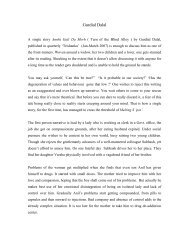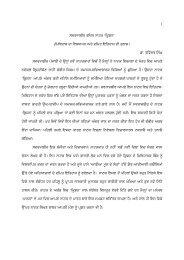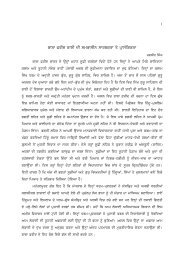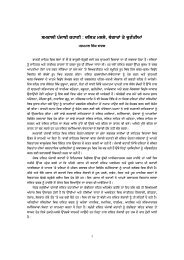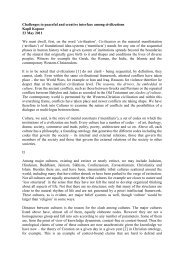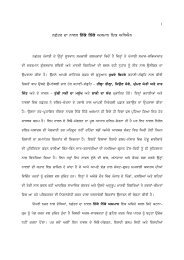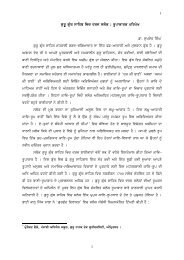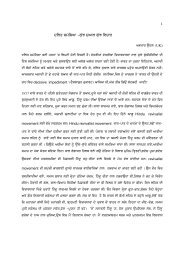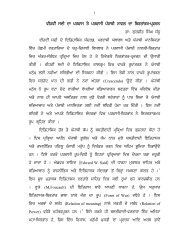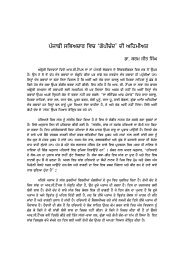Articles The Kind Tiger and the Truthful Cow ... - Panjabi Alochana
Articles The Kind Tiger and the Truthful Cow ... - Panjabi Alochana
Articles The Kind Tiger and the Truthful Cow ... - Panjabi Alochana
Create successful ePaper yourself
Turn your PDF publications into a flip-book with our unique Google optimized e-Paper software.
1<strong>Articles</strong><strong>The</strong> <strong>Kind</strong> <strong>Tiger</strong> <strong>and</strong> <strong>the</strong> <strong>Truthful</strong> <strong>Cow</strong>: Folk Discourse in Oral <strong>and</strong> WrittenLiteratureIt was a June evening in Bhubaneswar in 1993. My children asked me to tell <strong>the</strong>m astory, so I started narrating <strong>the</strong> well-known story "<strong>The</strong> Old <strong>Tiger</strong> <strong>and</strong> <strong>the</strong> GoldenBangle" about how an old tiger could not catch prey, so he cleverly promised to givegolden bangles to anyone who would take a dip in <strong>the</strong> nearby pond. None but <strong>the</strong>greedy Brahmin believed it, <strong>and</strong> when he was taking a dip, <strong>the</strong> tiger ate him.No sooner was <strong>the</strong> story completed than my gr<strong>and</strong>mo<strong>the</strong>r told me, "Don't you know,my boy, that if <strong>the</strong> Brahmin had made <strong>the</strong> tiger to take a vow before entering <strong>the</strong>pond, it would not have eaten him up." I was a bit puzzled to hear thismisrepresentation of a well-structured Sanskrit tale. Why should <strong>the</strong> Brahmin havetaken a vow from <strong>the</strong> tiger? My gr<strong>and</strong>mo<strong>the</strong>r explained that tigers like any o<strong>the</strong>rcreatures are subordinate to <strong>the</strong> truth. To this point, she in turn related <strong>the</strong> story of"Baula <strong>the</strong> <strong>Cow</strong>": A Brahmin had a cow named Baula, who used to go to <strong>the</strong> forest allby herself. One day on her way back from <strong>the</strong> jungle she met a tiger. <strong>The</strong> tiger wantedto eat her up, but Baula told <strong>the</strong> tiger that she had a three-day-old calf that was veryhungry. She pleaded <strong>the</strong> tiger to let her go back <strong>and</strong> feed it, promising to return aftershe had fed <strong>the</strong> calf. She repeated <strong>the</strong> promise three times <strong>and</strong> <strong>the</strong> tiger let her go.Baula fed her calf <strong>and</strong> returned to <strong>the</strong> tiger as promised, her calf running after her.When <strong>the</strong> tiger saw Baula <strong>and</strong> <strong>the</strong> calf, he could not believe it. Out of pity he let <strong>the</strong>cow free.Ano<strong>the</strong>r case in point would be <strong>the</strong> epic story "Savitri <strong>and</strong> Satyaban", where <strong>the</strong>protagonist is yama-<strong>the</strong> god of death in Indian mythology who let allowed <strong>the</strong> heroineSavitri to get back her deceased husb<strong>and</strong> Satyaban’s life due to <strong>the</strong> fact that He hadpromised Savitri to give three alms And it was due to <strong>the</strong> truth followed by Yama.In <strong>the</strong> Sanskrit story "<strong>The</strong> Old <strong>Tiger</strong> <strong>and</strong> <strong>the</strong> Golden Bangle", <strong>the</strong> tiger character isquite realistic, whereas in <strong>the</strong> tale "Baula <strong>the</strong> <strong>Cow</strong>" <strong>the</strong> tiger is portrayed unrealisticallyas a kind-hearted character. <strong>Tiger</strong>s are commonly regarded as cruel animals <strong>and</strong> notdepicted as kind-hearted, <strong>the</strong>refore <strong>the</strong> tiger in <strong>the</strong> Baula tale appears unnatural. Aparallel can here be drawn with stepmo<strong>the</strong>rs: <strong>the</strong> cruel stepmo<strong>the</strong>r is a common motifin folk tales, while <strong>the</strong> kind stepmo<strong>the</strong>r is very uncommon.Dan Ben Amos has correctly observed <strong>the</strong> social "order" <strong>and</strong> "disorder" current in <strong>the</strong>tradition of African folklore. According to him <strong>the</strong> creation of "order" is an attempt toconceptually duplicate reality verbally, to tell history as it is, to narrate experience as<strong>the</strong>y really happened <strong>and</strong> to recount visions as <strong>the</strong>y were actually seen. In contrast,narratives of "disorder" are for all intent <strong>and</strong> purpose verbal creations that establish aworld of a different reality, one that is unknown to ei<strong>the</strong>r speaker or listener (Amos1978)."Order" in a narrative is hereby understood as <strong>the</strong> actual reality, <strong>and</strong> "disorder" as <strong>the</strong>imaginary reality. Any piece of literature, ei<strong>the</strong>r oral or written, is a part of <strong>the</strong>
2imaginary reality. For instance, myths, legends, folk tales, oral epics <strong>and</strong> epicperformances are full of imaginary realities with <strong>the</strong> underlying actual reality. A goodpiece of literature expertly creates an imaginary reality through <strong>the</strong> use of similes,metaphors <strong>and</strong> symbols.Thus, disordered narratives are just as important as ordered ones. "<strong>The</strong> creation ofdisorder," says Amos, "could be interpreted as a verbal creation of wishful reality, adesired state of affairs that does not exist" (Amos 1978).<strong>The</strong> disordered narrative depicting a wishful reality created by <strong>the</strong> group mind allowsus to examine <strong>the</strong> narratives in terms of "order" <strong>and</strong> "disorder". <strong>The</strong> basic questions toask here are:1. Why is <strong>the</strong>re <strong>the</strong> "disorder" in a universally accepted character, such as a cruel tigerturning into a kind-hearted tiger? Why do people create <strong>and</strong> accept this?2. Why do people alter "ordered" literature <strong>and</strong> create different narratives?3. Why is <strong>the</strong>re a difference between "order" <strong>and</strong> "disorder"?We can also view contemporary Indian oral <strong>and</strong> written tradition from <strong>the</strong>se points ofview. Folklore is <strong>the</strong> collective creation of people: it has content, form, characters,performance context <strong>and</strong> social function; it carries meaning, communication <strong>and</strong>transformation. Oral narrative presents <strong>the</strong> minds of both <strong>the</strong> creator <strong>and</strong> <strong>the</strong> listener.Literature, whe<strong>the</strong>r oral or written, has individual, social <strong>and</strong> verbal implications.Verbal performance carries a meaning as well as has a specific purpose. Oral traditionnot only represents social realities but also attaches importance to imaginary realities.So literature, or any piece of art, is an embodiment of reality <strong>and</strong> imagination. Anynarration takes form depending on <strong>the</strong> age of <strong>the</strong> narrator, place of performance <strong>and</strong><strong>the</strong> audience addressed. Oral expression is <strong>the</strong> individual's creation embedded withcultural components of <strong>the</strong> society; no narrator st<strong>and</strong>s outside society.If <strong>the</strong> audience finds <strong>the</strong> narration acceptable, <strong>the</strong> narrator has been successful. Thusit is <strong>the</strong> audience that determines <strong>the</strong> success of a narration. If <strong>the</strong> audienceappreciates <strong>the</strong> disordered content of a particular narrative, <strong>the</strong>y must be trying toidentify <strong>the</strong>mselves with <strong>the</strong> imaginary reality that does not exist - but <strong>the</strong>y like it <strong>and</strong>believe it to be true.<strong>The</strong> aim of <strong>the</strong> current paper is to identify how social order <strong>and</strong> disorder are reflectedin oral tradition. <strong>The</strong> main question is why a particular character or event that issocially accepted as "ordered" is found "disordered" in folk literature. Why does thisrole reversal take place? To examine <strong>the</strong>se points, let us elaborate on some narrativemotifs common in <strong>the</strong> Indian society:1. Fire <strong>and</strong> women in <strong>the</strong> Indian society. Fire ordeal for women.2. <strong>The</strong> status of <strong>the</strong> youngest <strong>and</strong> eldest bro<strong>the</strong>r in <strong>the</strong> society.3. <strong>The</strong> sacred place: <strong>the</strong> temple, <strong>the</strong> city or <strong>the</strong> jungle?
34. Weak character versus strong character.Lets go in detail fopr each of <strong>the</strong> above mentioned points.1. Fire <strong>and</strong> Women in <strong>the</strong> Indian SocietyIndian literature includes innumerable motifs of fire <strong>and</strong> fire as related to women:being born of Agni-fire (e.g. Parvati), undergoing fire ordeal (e.g. Sita), taking a dailybath in fire (e.g. Draupadi) are but some examples. Indian women have a close linkwith fire from birth to death. Fire symbolizes <strong>the</strong> purity <strong>and</strong> austerity of women. <strong>The</strong>Indian woman takes a vow before sacred fire to accept one husb<strong>and</strong> for life; <strong>the</strong>fidelity of women is tested in fire ordeal.<strong>The</strong> authority of man over woman was <strong>the</strong> law in traditional India. This was owing totwo purposes: to keep <strong>the</strong> women chaste, <strong>and</strong> to have rights on women's property.<strong>The</strong>re are female goddesses in India (Durga, Laxmi, Saraswati, Parvati, etc.), but inreal life women are tortured, sexually abused, raped <strong>and</strong> murdered for bride price.Could it be that <strong>the</strong> worship of women as goddesses is a compensation for women'slow status in <strong>the</strong> society? Is it not <strong>the</strong>n <strong>the</strong> wishful reality to compensate for <strong>the</strong>natural loss through cultural sanction, i.e. creating female goddesses?Why fire ordeal for women only? Why not for men, too? Are <strong>the</strong>re any cases of malesundergoing <strong>the</strong> fire ordeal to prove his austerity? Not only in <strong>the</strong> great epic Ramayana,but also in many oral epics <strong>and</strong> narratives, <strong>the</strong> heroine has to make <strong>the</strong> fire ordeal toprove her chastity. In Ramayana, Sita had to undergo fire ordeal to establish herchastity, even though Rama did not doubt her chastity. Interestingly, in addition toRamayana, <strong>the</strong>re is a good deal of o<strong>the</strong>r mythological narratives where <strong>the</strong> heroine isto face fire ordeal to prove her chastity. Could this be due to <strong>the</strong> fact that <strong>the</strong>se storiesare written by men <strong>and</strong> thus represent male-dominated values? <strong>The</strong>re is no evidenceof protesting against <strong>the</strong> fire ordeal; on <strong>the</strong> contrary, women who have sacrificed <strong>the</strong>irlives in fire are deified. <strong>The</strong> worship of such satee in <strong>the</strong> form of "sati stone" is evidentin Orissa, Rajasthan <strong>and</strong> Madhyapradesh.One uncommon motif rejecting <strong>the</strong> stereotypes of fire ordeal for women only is foundin <strong>the</strong> folk tradition of central India. <strong>The</strong> case in point is <strong>the</strong> oral epic Lakshman jati,sung by <strong>the</strong> singers of Baiga community. <strong>The</strong> uniqueness of this oral epic lies in <strong>the</strong>fact that it is a folk version of <strong>the</strong> Ramayana episode with Lakshman, <strong>the</strong> youngerbro<strong>the</strong>r of Rama undergoing <strong>the</strong> fire ordeal instead of Sita. <strong>The</strong> story of <strong>the</strong> epic goesas follows:On <strong>the</strong>ir w<strong>and</strong>erings, Rama, Lakshman <strong>and</strong> Sita stopped at a Baiga village. Lakshmanused to play kikri-fiddle every night. His wonderful musical skills <strong>and</strong> <strong>the</strong> sweetness of<strong>the</strong> music attracted Indrakarnini - <strong>the</strong> heavenly maiden. She offered her love toLakshman, who refused her for <strong>the</strong> reason that he had been a Brahmachari forfourteen years <strong>and</strong> had not even touched <strong>the</strong> shadow of a woman. Out of anger,Indrakarnini took revenge on him by leaving her bangles <strong>and</strong> earrings in his bedroom.Lakshman did not know about this. In <strong>the</strong> morning when Sita cleaned Lakshman'sroom, she found <strong>the</strong> broken bangles <strong>and</strong> earrings <strong>and</strong> reported to Rama. Rama calleda village meeting where each <strong>and</strong> every woman was examined with <strong>the</strong> bangle <strong>and</strong>earrings. Interestingly, <strong>the</strong> earrings <strong>and</strong> bangles fitted only Sita. Rama's suspicion fellon Lakshman, so he had to undergo fire ordeal. He came out safe <strong>and</strong> proved his
4fidelity. Everyone was happy; but out of grief, Lakshman entered <strong>the</strong> ne<strong>the</strong>r regionPatala. (Elwin 1935)<strong>The</strong> narrative purports <strong>the</strong> "disordered" events <strong>and</strong> characters of Ramayana in tribalcontext. Why did Lakshman have to undergo <strong>the</strong> fire ordeal? Why not Sita? Thingsbecome clearer when we look into <strong>the</strong> context of <strong>the</strong> Baiga society <strong>and</strong> culture. <strong>The</strong>cultural context of this epic is <strong>the</strong> Baiga society. <strong>The</strong> epic song Lakshman jati isperformed with <strong>the</strong> accompaniment of <strong>the</strong> kikri-fiddle by <strong>the</strong> bards of <strong>the</strong> Taigas. <strong>The</strong>Baiga bards have moulded <strong>the</strong> character of Lakshman into a bard who is a member of<strong>the</strong> Baiga community. Lakshman had not accepted Srupanakha (,sister of Ravana,whois <strong>the</strong> villian of <strong>the</strong> ramayana) despite her request <strong>and</strong> in this epic story , Indrakaminiwas also rejected. But when Lakshman was suspected by his elder bro<strong>the</strong>r Rama, whatcould he do?Here it must be kept in mind that <strong>the</strong> heroes of Ramayana had no tradition of adoptingnon-Aryan women during <strong>the</strong>ir w<strong>and</strong>erings. <strong>The</strong>y did not even think of having morethan one wife. <strong>The</strong> situation is reversed in Mahabharata: Bhima <strong>and</strong> Arjun fell in lovewith <strong>the</strong> Naga, Rakshsa <strong>and</strong> Jakhya girls in course of <strong>the</strong>ir w<strong>and</strong>erings <strong>and</strong> did no<strong>the</strong>sitate to identify <strong>the</strong>m as <strong>the</strong>ir wives. However, in Ramayana this is a sin. SoLakshman had to undergo a fire ordeal.Fur<strong>the</strong>rmore, <strong>the</strong> flexible relationship of <strong>the</strong> younger bro<strong>the</strong>r with his elder bro<strong>the</strong>r'swife was common in tribal society. For <strong>the</strong> sake of <strong>the</strong> honour of having one, <strong>the</strong>relationship could also be fictitious. But <strong>the</strong> most important motif in this narrative isthat instead of Sita, Lakshman had to undergo <strong>the</strong> fire ordeal, which clearly indicates<strong>the</strong> male-female equality in tribal society. <strong>The</strong>refore <strong>the</strong> man has to be examined forfidelity first, <strong>and</strong> only <strong>the</strong>n <strong>the</strong> woman. So, singers have reinterpreted <strong>the</strong> written textto fit <strong>the</strong>ir socio-cultural context.2. <strong>The</strong> eldest bro<strong>the</strong>r <strong>and</strong> <strong>the</strong> youngest bro<strong>the</strong>rIn <strong>the</strong> traditional Indian society, <strong>the</strong> eldest bro<strong>the</strong>r always becomes <strong>the</strong> king <strong>and</strong> <strong>the</strong>youngest bro<strong>the</strong>r carries his sunscreen. So <strong>the</strong> relationship of <strong>the</strong> youngest bro<strong>the</strong>rwith <strong>the</strong> eldest is like that of an umbrella over <strong>the</strong> throne; but <strong>the</strong> umbrella has nopower. Similarly, <strong>the</strong> eldest bro<strong>the</strong>r in <strong>the</strong> family possesses <strong>the</strong> utmost power in <strong>the</strong>Indian society. In royal families <strong>the</strong> eldest bro<strong>the</strong>r was to become <strong>the</strong> king after hisfa<strong>the</strong>r, not <strong>the</strong> youngest. In South India, <strong>the</strong> eldest son of a Nambudri Brahmin couldbecome a priest, while <strong>the</strong> youngest bro<strong>the</strong>r could not. <strong>The</strong> social rules of <strong>the</strong> Indiantradition thus left no room for <strong>the</strong> younger bro<strong>the</strong>r, though it is true that in <strong>the</strong>absence of parents, it is <strong>the</strong> eldest bro<strong>the</strong>r who nourishes younger ones.In <strong>the</strong> Indian joint family system, <strong>the</strong> eldest bro<strong>the</strong>r is entitled to enjoy <strong>the</strong> l<strong>and</strong> <strong>and</strong>property on a bigger scale than <strong>the</strong> younger ones. Traditionally, younger bro<strong>the</strong>rs donot fight against <strong>the</strong> elders. <strong>The</strong>re is little evidence of a youngest bro<strong>the</strong>r ascending<strong>the</strong> throne at <strong>the</strong> cost of his elder bro<strong>the</strong>r.<strong>The</strong>refore in Ramayana, Bharata (<strong>the</strong> younger bro<strong>the</strong>r of Rama) did not ascend <strong>the</strong>throne even though he had <strong>the</strong> opportunity. Instead, he put Rama's shoes on <strong>the</strong>throne <strong>and</strong> ruled Ayodhya during Rama's exile for fourteen years.
5In classical epics <strong>and</strong> puranas, we witness that <strong>the</strong> eldest bro<strong>the</strong>r enjoys enormouspower. <strong>The</strong> youngest bro<strong>the</strong>rs are never depicted as prominent in <strong>the</strong> Purana <strong>and</strong>Kavya tradition. In Ramayana <strong>and</strong> Mahabharata younger bro<strong>the</strong>rs like Satrughna,Nakula <strong>and</strong> Sahadeva were not as glorious as Rama, Lakshmana, Arjuna <strong>and</strong> Bhima.In a way, this explains why Rama <strong>and</strong> Laxman are worshipped, <strong>and</strong> Bharat orShatrughna are not.On <strong>the</strong> o<strong>the</strong>r h<strong>and</strong>, in many regional epics, folk tales, romances <strong>and</strong> oral epics <strong>the</strong>hero is a younger bro<strong>the</strong>r.1 He leaves <strong>the</strong> house being neglected by elder bro<strong>the</strong>rs <strong>and</strong><strong>the</strong>ir wives. <strong>The</strong>n he gets a divine blessing <strong>and</strong> enjoys supernatural powers, makes <strong>the</strong>impossible possible, wins <strong>the</strong> enemies, has success in love <strong>and</strong> war. He regains his lostpower from his elder bro<strong>the</strong>rs; in some cases, <strong>the</strong> youngest bro<strong>the</strong>r kills <strong>the</strong> eldestbro<strong>the</strong>r.<strong>The</strong> importance of <strong>the</strong> younger bro<strong>the</strong>r in folk tales is a universal motif. In <strong>the</strong> story"Search for <strong>the</strong> Golden bird" (Th 550) <strong>the</strong> king has promised half <strong>the</strong> kingdom towhoever fetches <strong>the</strong> golden bird. Out of three bro<strong>the</strong>rs, none o<strong>the</strong>r than <strong>the</strong> youngestbrings <strong>the</strong> golden bird <strong>and</strong> is awarded with half <strong>the</strong> kingdom (Thompson 1960).<strong>The</strong> Gond <strong>and</strong> Bhunjia tribes of Western Orissa have a number of folk tales, whichheroize <strong>the</strong> youngest bro<strong>the</strong>r. <strong>The</strong> precise form of such a tale is as follows:<strong>The</strong>re lived an old man <strong>and</strong> his wife. <strong>The</strong>y had two sons. <strong>The</strong> elder bro<strong>the</strong>r was hardworking <strong>and</strong> took care of his parents. <strong>The</strong> younger was a lazy one, never doing anywork. One day <strong>the</strong> old man rebuked his younger son, saying "You are an ass. Youshould die. I do not want to see your face anymore. Get out of my house."So <strong>the</strong> younger bro<strong>the</strong>r left his house. Before leaving <strong>the</strong> village, he met <strong>the</strong> girl hewas to marry. No sooner had he completed his story than he turned into an ass. <strong>The</strong>girl felt very sorry for him <strong>and</strong> left <strong>the</strong> village with <strong>the</strong> ass. She went to ano<strong>the</strong>rkingdom where all <strong>the</strong> women were infertile. <strong>The</strong> king of that country asked <strong>the</strong> girl todo something about it. <strong>The</strong> girl worshipped a dry sal-tree. All of a sudden <strong>the</strong> treesprouted leaves; <strong>and</strong> when <strong>the</strong> tree bloomed, all women in <strong>the</strong> kingdom becamepregnant. <strong>The</strong> youngest bro<strong>the</strong>r transformed back into a human, too. <strong>The</strong> king was sograteful that he gave <strong>the</strong>m half <strong>the</strong> kingdom.Ano<strong>the</strong>r Gond story runs like this:An old Gond had seven sons. All but <strong>the</strong> youngest, Chittal Singh were married. Oneday <strong>the</strong> eldest five bro<strong>the</strong>rs killed him in <strong>the</strong> field, but Mahaprabu brought him back tolife. He left <strong>the</strong> village vowing to revenge his elder bro<strong>the</strong>rs. He had acquiredsupernatural powers from <strong>the</strong> goddess <strong>and</strong> he had three friends with supernaturalpower, who agreed to help him. Chittal married <strong>the</strong> daughter of a demons. When hiswife was abducted by a tantric yogi, he killed <strong>the</strong> yogi. On <strong>the</strong> way back from <strong>the</strong>re, hefaced a formidable foe, but killed him. Finally, on his way home he killed all his elderbro<strong>the</strong>rs, except <strong>the</strong> sixth bro<strong>the</strong>r who had favoured him.In tribal society <strong>the</strong> struggle for power <strong>and</strong> l<strong>and</strong> with elder bro<strong>the</strong>rs not giving <strong>the</strong>youngest <strong>the</strong>ir equal share is constant. So <strong>the</strong> younger bro<strong>the</strong>r is a hero in narratives,tales <strong>and</strong> epics, whereas in real life he is neglected <strong>and</strong> in <strong>the</strong> Purana <strong>and</strong> Itihasa
6(myths <strong>and</strong> epics) <strong>the</strong> eldest bro<strong>the</strong>r is a hero.3. <strong>The</strong> sacred place: <strong>the</strong> temple, <strong>the</strong> city or <strong>the</strong> jungle?Today, cities are <strong>the</strong> accepted centres of power. <strong>The</strong> ruler <strong>and</strong> <strong>the</strong> capital are <strong>the</strong>powers which rule <strong>the</strong> state; villages <strong>and</strong> jungle have no power. However, in actualfact <strong>the</strong> sources of revenue is not <strong>the</strong> cities; village people give power to <strong>the</strong> ruler.When power is violated, it is people that change <strong>the</strong> system. Power is shifted from oneruler to ano<strong>the</strong>r.In <strong>the</strong> Indian tradition, <strong>the</strong> sage, or sanyasi was more powerful than <strong>the</strong> king. <strong>The</strong>importance of sages is manifest in Purana <strong>and</strong> Itihasa. Powerful rulers needed <strong>the</strong>blessings <strong>and</strong> advice from sages to govern <strong>the</strong>ir state. <strong>The</strong> inauguration ritual of <strong>the</strong>new king was performed in <strong>the</strong> presence of sages supported by tribal chieftains,symbolizing <strong>the</strong> recognition of <strong>the</strong> king by <strong>the</strong> people as well as <strong>the</strong> king's acceptanceof his position. <strong>The</strong> king's deviation from laws was considered improper for rulers <strong>and</strong>was subject to criticism by <strong>the</strong> sages.<strong>The</strong> question of <strong>the</strong> sacred <strong>and</strong> profane is important in <strong>the</strong> Indian culture. Temples arecommonly considered more sacred than any o<strong>the</strong>r place. People have created anumber of beliefs as to what is sacred <strong>and</strong> profane, attaching values <strong>and</strong> attitudes toplaces <strong>and</strong> things. Those values <strong>and</strong> concepts can be seen in <strong>the</strong> form of practices,rituals <strong>and</strong> rites. Temple is a sacred place, but in tribal <strong>and</strong> folk tradition <strong>the</strong>re is amore sacred place than <strong>the</strong> temple - <strong>the</strong> jungle. Although it is a sacred center, <strong>the</strong>purity of <strong>the</strong> temple is maintained through certain rituals. Orissa, <strong>the</strong> place of origin ofseveral gods <strong>and</strong> goddesses, is considered to be an eternally sacred place. All gods<strong>and</strong> goddesses originate in some temple, cave, mountain, or river far away fromhuman settlements; <strong>the</strong>n some priest discovers <strong>the</strong> god or goddess in <strong>the</strong> jungle, <strong>and</strong><strong>the</strong> king of <strong>the</strong> state builds a temple <strong>and</strong> installs statues. Some examples to <strong>the</strong> pointwould be:SlNoOriginalformPriestPlaceInstalledformPriestPlace/temple1NeelamadhabStone imageSavaraNeela giriLordJagannathBalabhadraSubhadraBrahmin Puri2 Manikeswari KshyatriyaKashipur,jugsaipatnaManikeswari Brahmin Bhavanipatna3 RakatmailiK<strong>and</strong>haTribePalmagarh Raktambari Brahmin Khariar4 Duarsani Bhunjia Gurudangra Duarsani Gond BodenInterestingly, in Kalah<strong>and</strong>i it is believed that <strong>the</strong> original power (sakti) of <strong>the</strong> gods <strong>and</strong>
7goddesses lies in <strong>the</strong>ir place of origin <strong>and</strong> not <strong>the</strong> temple. So every year during <strong>the</strong>Dashara festival, a ritual of symbolically bringing sakti from <strong>the</strong> place of origin, isconducted; this is believed to give <strong>the</strong> goddess of <strong>the</strong> temple a new life. Soon after <strong>the</strong>ten-day Dasahara ritual is over, <strong>the</strong> sakti is taken back to <strong>the</strong> place of origin throughano<strong>the</strong>r ritual.<strong>The</strong> above tells us that <strong>the</strong> non-human existence of gods in <strong>the</strong> jungle is pure <strong>and</strong>sacred, whereas <strong>the</strong> human relationship with gods in temple is less pure. Sometimes<strong>the</strong> temple relationship becomes even profane when <strong>the</strong> rules <strong>and</strong> practices forretaining purity are not followed. Hence, <strong>the</strong> reincarnation of temple goddess via saktifrom <strong>the</strong>ir place of origin validates <strong>the</strong>m. <strong>The</strong> logic behind this practice is that it is <strong>the</strong>man who contaminates <strong>the</strong> place, <strong>and</strong> for purification <strong>the</strong> presence of a divine power isneeded. <strong>The</strong> jungle is sacred, as it is <strong>the</strong> abode of gods <strong>and</strong> goddesses.K<strong>and</strong>abora is one such rite practised by <strong>the</strong> Bhunjia tribe of western Orissa thatsymbolises <strong>the</strong> sacredness of <strong>the</strong> jungle.<strong>The</strong> Bhunjias believe that it is <strong>the</strong> sacred jungle that purifies <strong>the</strong> impure human being.<strong>The</strong> rite is as follows: Kondabora is a symbolic ritual of <strong>the</strong> Bhunjias where <strong>the</strong> girl ismarried to an arrow before she reaches puberty. But if a girl attains puberty before <strong>the</strong>Kondabora rite, she is considered sinful <strong>and</strong> <strong>the</strong> house, as well as <strong>the</strong>ir god becomesimpure. <strong>The</strong> common practice among <strong>the</strong> Bhunjia is that if a girl attains puberty in herfa<strong>the</strong>r's house before <strong>the</strong> Kondabora, she is exiled to <strong>the</strong> jungle <strong>and</strong> tied to a tree tillher uncle or close relatives rescue her. <strong>The</strong> Bhunjia consider <strong>the</strong> jungle to havesupernatural powers to purify <strong>the</strong> girl. <strong>The</strong> Bhunjia worship a living tree, which is <strong>the</strong>symbol of <strong>the</strong> purity of gods <strong>and</strong> goddesses. <strong>The</strong> tree is sacred, but <strong>the</strong> man is not;<strong>the</strong> man is impure. Gods <strong>and</strong> goddesses speak through humans only so long as <strong>the</strong>mind <strong>and</strong> heart of <strong>the</strong> mediator are pure. In rural <strong>and</strong> tribal India, <strong>the</strong> jungle has been<strong>the</strong> center of power <strong>and</strong> attainment of truth, vision, <strong>and</strong> aes<strong>the</strong>tics. <strong>The</strong> non-human issomething related to spirit <strong>and</strong> nature, while <strong>the</strong> existence of <strong>the</strong> human is impure.4. Weak character versus strong characterIn folk tales, strong characters are less intelligent than <strong>the</strong> weak. Such motifs arecommon in animal stories, for example. Such oppositions are most evident in <strong>the</strong> oraltribal epics; minor ethnic groups portray <strong>the</strong> stronger ethnic group exercising powerover <strong>the</strong>m as inferior. So, in a way, <strong>the</strong> smaller ethnic groups have a strong sense ofsolidarity to retain <strong>the</strong>ir ethnic identity <strong>and</strong> superiority (Mishra 1995).Summary<strong>The</strong> creation of such worldviews <strong>and</strong> ideologies is parallel to <strong>the</strong> written discourse: <strong>the</strong>wishful realities created by people. <strong>The</strong> whole picture of <strong>the</strong> Indian society <strong>and</strong> culturecan not be understood unless one considers <strong>the</strong> discourse in <strong>the</strong> context of <strong>the</strong> Indianfolk tradition. On <strong>the</strong> o<strong>the</strong>r h<strong>and</strong>, written discourse represents only <strong>the</strong> "ordered"society. Hence <strong>the</strong> creation of <strong>the</strong> "disordered" in folk tradition is only to counteract<strong>the</strong> forces dominant in society. Thus folk discourse reveals ano<strong>the</strong>r reality of <strong>the</strong>Indian society, a different worldview of <strong>the</strong> "ordered" society.
8References:• Amos, Dan Ben 1978. Folklore in Context. Essays. Delhi.• Thomson, S. & Robert, W. E. 1960. Types of Indian Oral Tales. FFC. Helsinki.• Mishra, M.K. 1995. Ethnic Identity <strong>and</strong> Oral Narratives. Tribal Language <strong>and</strong>Culture of Orissa. Ed. by K. Mahapatra. Bhubaneswar.• Mishra, M. K. 1995. Paschima Odisara Adibasi Lok Sahitya. Bhubaneswar.Contact Address:Dr. Mahendra Kumar MishraIV-B, 45/2, Unit - III,Bhubaneswar - 751001Orissa, IndiaPhone # : 091 - 0674 - 405483Email : mahendra_ku@yahoo.com



